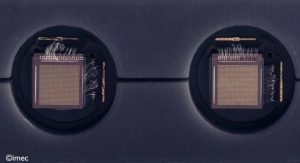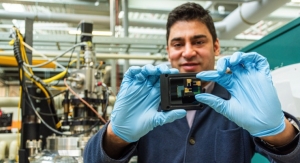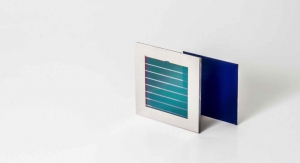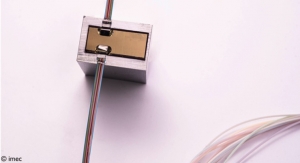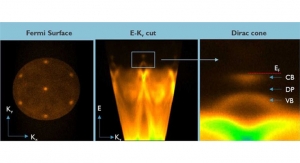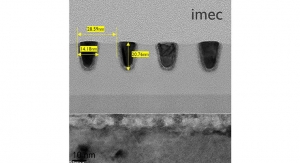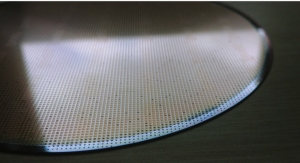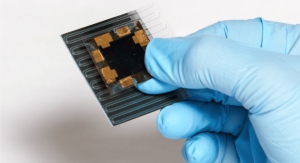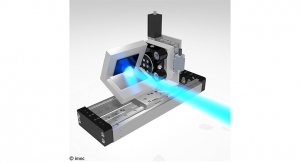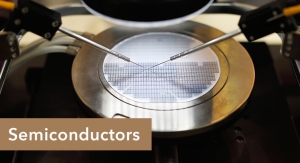11.16.18
At the imec technology forum Japan (ITF Japan 2018), imec, the Ghent University (UGent), and contact lens manufacturer SEED Co., Ltd. said they have developed a contact lens with an integrated LED light, including an ultra-thin silicon microchip, a radio‐frequency antenna for wireless energy transfer, and stretchable thin‐film interconnections.
Different from the traditional contact lens-type wearable devices made of non-water-containing material, this device is made of hydrogel-based material. This demonstration of autonomous electronics in hydrogel-based soft lenses opens the door to unique applications such as lenses with sensors and/or drug-delivery systems for the treatment of different eye disorders, at the congenital, post-surgery or trauma level. The main advantages of such devices are their low invasiveness level and continuous monitoring in an almost imperceptible manner.
About 130 million people worldwide wear contact lenses, mainly to correct their vision. Now, with electronic systems getting ever smaller and with the possibility of having electrical power on-lens, it becomes feasible to integrate a variety of transducers (i.e. physical, biochemical, etc.) into a lens. This is interesting for diagnosing and treating ocular diseases. The challenge is to integrate a completely autonomous system and make it as flexible as a soft lens, without compromising its oxygen-permeable nature and the integrity of the electronics components.
CMST, an imec research group at Ghent University, together with SEED Co., Ltd., demonstrated a semi-passive smart lens with blue LED light powered by an RF coupling. Besides power transfer, the RF link can be used to calibrate the integrated transducers and reading the sensors out into a handheld device for further post-processing. The spherical‐shaped electronics were made by imec/CMST, whereas SEED Co., Ltd. was responsible for the seamless integration into the hydrogel-based soft lens. The interconnect substrate is based on thermoplastic polyurethane, a material with a low glass transition temperature, relatively low hardness, proven biocompatibility, optical transparency, conformal fitting, oxygen permeability, and flexibility comparable with soft contact lenses (e.g., hydrogel‐based).
Moreover, the viscoelastic nature of TPU allows planar structures to be thermoformed into spherical caps with a well‐defined curvature (i.e., eye's curvature at the cornea: 9 mm). Very precise fine‐tuning of the thermoforming parameters and optimization of strain‐release patterns enabled to achieve oxygen permeable, thin, non-developable, and wrinkle‐free contact lenses with integrated electronics. Well-chosen gaps in the circuit provide for oxygen permeability of the lens.
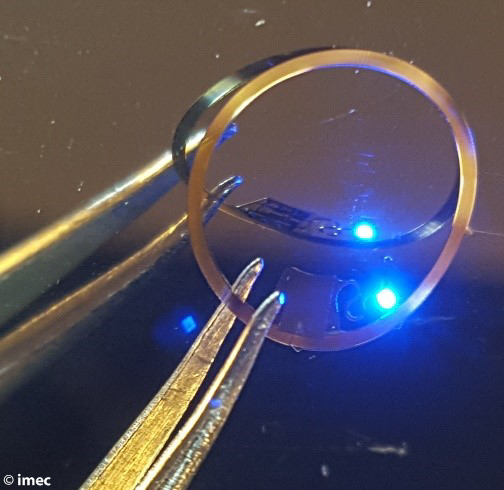
“Flexible and stretchable electronics hold a lot of promise for medical applications,” said Andrés Vásquez Quintero, imec researcher and professor at UGent. “They can be integrated into intelligent clothing, and even – when combined with highly miniaturized electronics – in smaller devices such as contact lenses. Major challenges have to be overcome to make a truly autonomous smart lens which is comfortable to wear and stable for a few days or even weeks. The integration of a LED light in a semi-passive RF wireless platform is the first important step towards a device that will change the lives of many.”
Different from the traditional contact lens-type wearable devices made of non-water-containing material, this device is made of hydrogel-based material. This demonstration of autonomous electronics in hydrogel-based soft lenses opens the door to unique applications such as lenses with sensors and/or drug-delivery systems for the treatment of different eye disorders, at the congenital, post-surgery or trauma level. The main advantages of such devices are their low invasiveness level and continuous monitoring in an almost imperceptible manner.
About 130 million people worldwide wear contact lenses, mainly to correct their vision. Now, with electronic systems getting ever smaller and with the possibility of having electrical power on-lens, it becomes feasible to integrate a variety of transducers (i.e. physical, biochemical, etc.) into a lens. This is interesting for diagnosing and treating ocular diseases. The challenge is to integrate a completely autonomous system and make it as flexible as a soft lens, without compromising its oxygen-permeable nature and the integrity of the electronics components.
CMST, an imec research group at Ghent University, together with SEED Co., Ltd., demonstrated a semi-passive smart lens with blue LED light powered by an RF coupling. Besides power transfer, the RF link can be used to calibrate the integrated transducers and reading the sensors out into a handheld device for further post-processing. The spherical‐shaped electronics were made by imec/CMST, whereas SEED Co., Ltd. was responsible for the seamless integration into the hydrogel-based soft lens. The interconnect substrate is based on thermoplastic polyurethane, a material with a low glass transition temperature, relatively low hardness, proven biocompatibility, optical transparency, conformal fitting, oxygen permeability, and flexibility comparable with soft contact lenses (e.g., hydrogel‐based).
Moreover, the viscoelastic nature of TPU allows planar structures to be thermoformed into spherical caps with a well‐defined curvature (i.e., eye's curvature at the cornea: 9 mm). Very precise fine‐tuning of the thermoforming parameters and optimization of strain‐release patterns enabled to achieve oxygen permeable, thin, non-developable, and wrinkle‐free contact lenses with integrated electronics. Well-chosen gaps in the circuit provide for oxygen permeability of the lens.

“Flexible and stretchable electronics hold a lot of promise for medical applications,” said Andrés Vásquez Quintero, imec researcher and professor at UGent. “They can be integrated into intelligent clothing, and even – when combined with highly miniaturized electronics – in smaller devices such as contact lenses. Major challenges have to be overcome to make a truly autonomous smart lens which is comfortable to wear and stable for a few days or even weeks. The integration of a LED light in a semi-passive RF wireless platform is the first important step towards a device that will change the lives of many.”


